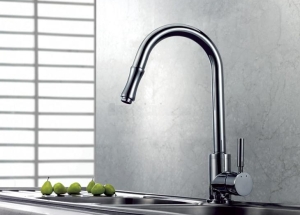The secret dream of any housewife is that in the kitchen a beautiful and convenient kitchen mixer for compact washing was installed. Thanks to the precise functioning of the mixer, any homework in the kitchen becomes comfortable and quick.
Content
Agree that the modern kitchen faucet is a variety of shapes, materials and stunning design. The variety of forms is constantly updated with a new stylish design, so the best models are yet to come.

Kitchen mixers, what they are
Traditional kitchen mixers are your reliable partner, therefore requirements to it are presented, in a friendly way, very strict.
The main requirements for kitchen faucets are:
• simplicity and ease of management
• original and reliable construction
• high water spillage with a turn
• housing that retains a pristine state for a long time.

From what materials are made mixers
Mixers are made of metal, metal alloys, plastic, bronze and granite.
The most used material for manufacturing mixers are metal and metal alloys. The vast majority of cases of sanitary ware for the kitchen are made of metal. Low-quality and cheap imitation of silumin can be distinguished immediately by weight, it will be easier for a city than a metal one. All other elements of the mixer can be made of bronze or brass with mandatory chrome surface.

Why is the use of materials such as brass and bronze most in demand? These materials are resistant to aggressive water environment, from the inside there is practically no lime scale on the walls. Aesthetic component allows you to successfully fit the mixer in any most refined interior.
How to choose the right mixer for the kitchen can be learned from experts.
Ways to switch the mixers on
The main distinguishing parameter of the mixer is the method of inclusion. Depending on the technology, the mixers are divided according to the following switching methods:
• single lever
• two-valve
• Non-contact.
Single-lever Mixers are simple in the device and convenient to adjust. The only movement of the hand allows mixing of cold and hot water. And the whole secret lies in the two internal combined spherical surfaces responsible for the adjustment. The alignment of the surface in a given direction regulates the jet head and temperature.

A familiar design that can be found in almost every kitchen is two-valve mixers. Two crane beams, combined with each other, regulate the supply of cold and hot water. Since the appearance of such structures with two signal caps of the blue "hol" and red "mountains", which reminded of the temperature state, a lot of water has flowed ...

But the two-valve system, with its strict economy of water and control of pressure, played, perhaps, a revolutionary role in the "dictatorship" of the mixers. Even the rubber gasket, constantly deforming and calling for decisive action, did not prevent the appearance of the best mixers for the kitchen.
Here, they, these proud, creative and gorgeous "gills" of the Age of Aquarius.
To replace the lever and faucet mixer quickly came non-contact and electronic.
The contactless or sensory mixers are distinguished only by the presence of a spout. Water starts to flow thanks to the capture by the built-in hand movement sensor. The zone of hypersensitivity of the built-in sensor is up to 30 cm. The water starts to flow after a certain time, after about 3 seconds and ceases to flow through the same time interval. The obvious convenience is in the settings of the water, and there is no reason for excitement in the event of leaving home and an annoying bothersome question: "Did you close the water". From accurate automation without your presence, not only snow will not be interrogated from the mixer, but it will not give a drop of water. But these mixers have additional functions: a thermostat and built-in filter, lighting, as well as a container for liquid soap. There is also the possibility of limiting the maximum temperature.
If you think that this is fantastic, then no, it's a non-contact faucet for the kitchen.
Spout of kitchen faucets
The design of any kitchen faucet differs from the mixer in the bathroom in the form of a spout. This is a fundamental issue regarding the mixer, because the water jet in the kitchen should fall into the center of the kitchen sink. Therefore, the choice of mixers for the kitchen should be given to models with an average spout height. In this case, the water jet will not splash, and working under such a strictly directed water jet is very comfortable. When choosing a mixer, you need to consider the volume of the sink. The most comfortable design of the spout is the rotary structure. The swivel design allows the use of a spout to fill any voluminous economic capacity. If the spout is low enough, in this case it is equipped with a special pull-out shower with adjustable handle and watering can.

Pull out mixers and faucets-showers
The shower mixer for the kitchen is a standard mixer, complete with a flexible shower with a nozzle (watering can). A flexible hose with a distributor nozzle is stored inside the sink. The outside is a watering can, which can be used at any time. The rest of the time, the flexible hose is not visible and does not interfere with operation.

Excellent proved itself in the kitchen pull-out mixer. In such models, the flexible hose is pulled out, if necessary, from the nozzle or the body of the mixer. You immediately have several degrees of freedom of action. If necessary, you direct the body of the pull-out mixer or simply pull out the flexible hose for work.
And, finally, the dream of any mistress, an electronic mixer. Yes, he does everything himself, just click on the necessary button. Do not believe me? Then look at the proposed video "for sweet".
Electronic mixer from the brand.



















